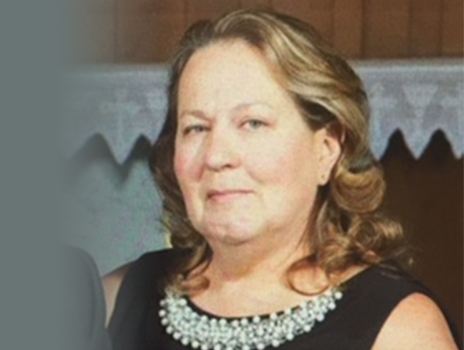- Home
- News Room
- Patient Stories
- Breast Cancer Survivor Regains Sense of Self After Reconstruction
April 05, 2019
During her 42 years as a nurse, Cathie Fitzgerald has seen good doctors and exceptional doctors.
But it wasn’t until she became a breast cancer patient that she met the "nicest physician in the world," plastic surgeon Eric Lai, MD.
Cathie was 59 when she learned she had breast cancer in 2015. Uncomfortable with her care at another area healthcare facility, she requested a second opinion at The University of Kansas Cancer Center. There, she met with breast oncologist Anne O’Dea, MD and Dr. Lai.
Dr. O’Dea diagnosed Cathie with stage IIA, ER/PR-positive, HER2-negative cancer. She had two tumors in her right breast. Her treatment plan included an estrogen-blocking medication and a skin-sparing, single mastectomy. Based on her cancer markers, Cathie did not require chemotherapy or radiation.
She had taken the first and most important steps toward a cancer-free life. But there would be many more steps before Cathie felt whole again. Her plastic surgery team was with her from the beginning, outlining her breast reconstruction options.
Women have rights
According to Dr. Lai, most women with breast cancer – 7 out of 10 – are not aware there is a federal law in place to protect them if they choose to have breast reconstruction after a mastectomy. According to the American Cancer Society, the law requires most group insurance plans that cover mastectomies to also cover breast reconstruction.
The Women’s Health and Cancer Rights Act (WHCRA) of 1998 mandates that any insurance policy guaranteeing coverage for mastectomy must also guarantee coverage for complications such as lymphedema and operations to create breast symmetry. At The University of Kansas Health System, every patient knows their breast reconstruction options.
New breasts can be created with silicone and/or saline implants or the patient’s own body tissue. Women can choose to go smaller than, larger than, or the same size as their original breasts. Women with cancer in one breast can reduce, enlarge or lift their healthy breast to match the reconstructed breast.
"Each patient is different," explains Dr. Lai. "The type of cancer, the extent of their surgery, the need for radiation and the woman's personal goals guide our decisions about reconstruction. We provide recommendations, but the final choice is always hers."
Dr. Lai says Cathie had realistic expectations for reconstruction. She wanted to look symmetrical in her clothes.
Keeping the faith
As soon as Cathie’s mastectomy was complete, Dr. Lai entered the operating room to begin her reconstruction. He placed a tissue-expander under her right pectoral muscle.
Cathie remembers being overwhelmed by the kindness she received on surgery day from Dr. Lai and his team.
The reconstruction process requires several weekly visits to plastic surgery at The University of Kansas Health System. The expander pouch is gradually filled with saline to make room for the implant. That's how Cathie met Dr. Lai's dedicated breast reconstruction nurse, Jenny Norris, RN.
"Breast reconstruction is a long process," explains Jenny. "Women share a lot about their personal lives with me. I tell them to think of me as their advocate, their safe place, their friend."
To achieve optimal results, 4 separate reconstruction surgeries were required. Dr. Lai removed the tissue expander and inserted the implant in her right breast. He also transplanted fat from other parts of her body to round out her new breast.
"Her treatment had a few hiccups due to a wound-healing issue," says Dr. Lai. "Wound healing can be challenging, but thanks to her nursing skills and spunky personality, she kept going even when things were challenging."
"I applaud Cathie for keeping her sense of humor throughout the reconstruction process," says Jenny. "She laughed through tears sometimes. But she stuck with it."
The final step was a 3D nipple tattoo. Cathie raves, "They have a great tattoo-artist. It looks like the real thing!"
What to wear
Another aspect of reconstruction that women may not expect to discuss with their physician is appropriate undergarments after breast reconstruction.
"After reconstruction surgery, many women find underwire and shaped-cup bras painful, uncomfortable or unnecessary," says Dr. Lai. "They prefer something lighter and less clunky like a camisole, bralette or tank top."
The breast cancer team often refers patients to Missys' Boutique®, an accredited cancer appearance center located on the main level of the Richard and Annette Bloch Cancer Care Pavilion in Westwood, Kansas.
Missys' offers a wide selection of postoperative camisoles with drain support, breast forms, compression garments and bra options. Licensed professionals can help with fittings in a private room.
Sharing her story
Cathie wants breast cancer patients to know it gets better. "Having your breast removed is a big deal," says Cathie, "but I'm stronger now. I'm 3 years cancer-free. And I don't get upset over the little stuff. I laugh a lot."
Throughout her reconstruction and recovery, Cathie relied on Dr. Lai and Jenny for support. "We were in it together," she says.
Cathie also counted on her 2 sons and their wives. Her grandchildren Brodie, 3, and January, 5, also kept their "nanna" smiling.
When first diagnosed, Cathie lived in Cainsville, Missouri. Today, she lives in Independence, closer to her family and The University of Kansas Health System. She encourages breast cancer patients in western Missouri to drive past other hospitals and clinics.
"If you want to be a survivor, go where they know and follow the latest protocols," says Cathie. "After my wonderful experience, I’m a patient here for life."
